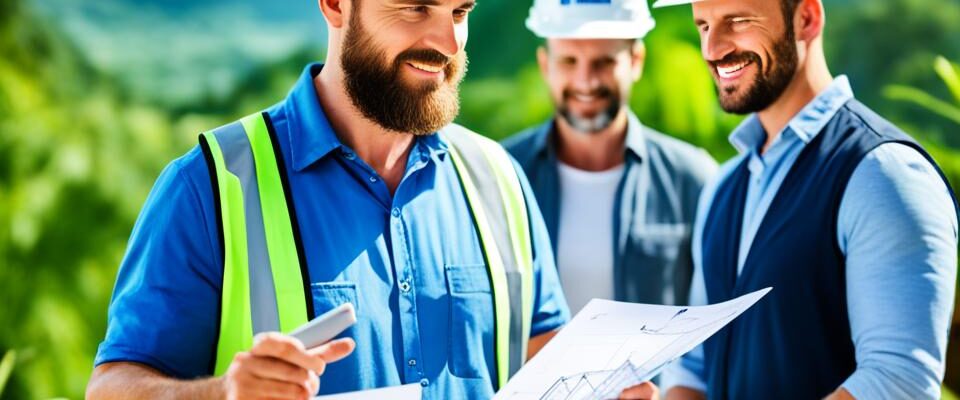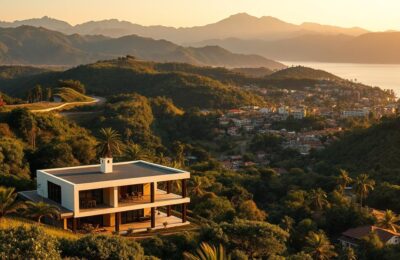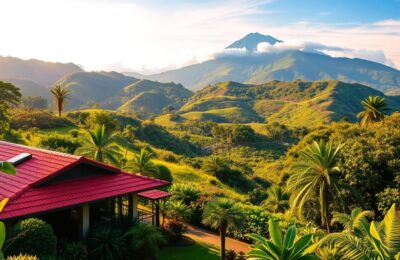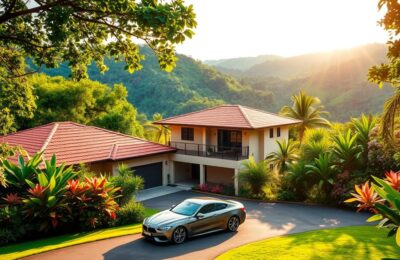About Costa Rica Home Builders: What You Need To Know
Costa Rica is known for its warm weather, stunning landscapes, and friendly people. It’s a dream spot for those moving or retiring abroad. Many folks want to build their own home here. A custom home offers unique comforts you might not find in a prebuilt one.
Or maybe you’re thinking of investing and building a dream rental property. This could be a way to earn extra income later. But, what does it take to build a house in this tropical paradise? Let’s dive into the process of building a house in Costa Rica. We’ll cover finding the right lot, hiring experts, designing your home, and understanding costs.
Key Takeaways
- Costa Rica is a popular destination for those seeking to build a custom home or investment property.
- The process of building a house in Costa Rica involves navigating various legal, logistical, and financial considerations.
- Hiring the right professionals, such as a reliable attorney and experienced contractor, is crucial for a successful home-building project.
- Understanding the cost factors, including regional variations and additional taxes, is important for budgeting and planning.
- Adhering to environmental regulations and obtaining necessary permits are essential steps in the home-building process in Costa Rica.
The Appeal of Building a Home in Costa Rica
Costa Rica is a top choice for building your dream home. It boasts beautiful landscapes, a warm climate, and a friendly culture. This makes it ideal for luxury homes, custom designs, and eco-friendly building. Building here can be a fulfilling experience, whether for a personal retreat or a real estate investment.
One big draw is the chance to design your home just how you want it. You can pick the style, layout, and materials that fit your style and values. This customization is perfect for those wanting a unique home in a tropical setting.
Costa Rica’s architecture scene is also growing, with experts in sustainable homes. These builders focus on homes that blend into the environment and use less energy. Your dream home will look great and be good for the planet.
Buying a home in Costa Rica can also be a smart money move. The real estate market is getting more popular, offering more luxury and custom homes. This makes it easier to find the perfect property or work with builders to create your dream home.

Plus, your home can earn money through rentals. Costa Rica’s tourism and expat community mean there’s a big demand for places to stay. This can help pay for your home and make your project profitable.
Building a home in Costa Rica means making a space that matches your life and fits into a growing market. It’s a chance to build a luxury retreat or a solid investment. The idea of making a custom home in this beautiful place is very tempting.
Finding a Suitable Lot to Build
Finding the right land is key when building a home in Costa Rica. Experts in Puntarenas and Guanacaste stress the need to work with a good real estate agent and lawyer. They help guide you through this important step.
Key Considerations
Looking for a home in Costa Rica means checking several things. You need to see if there’s a reliable water source, electricity, and internet. Also, look into the road access, property boundaries, and local zoning laws.
Costa Rica has rules for building lots. They must be at least 350 square meters for homes and 5,000 square meters for farms. The main house on a farm can’t be bigger than 300 square meters.
Urban lots can be different sizes and often have public roads. Farm lands are usually over 2.5 acres. It’s important to know these details before buying.
Make sure the land has a legal water source, like from the public water authority or a private association. Also, confirm there’s electricity with a “Carta de luz”. A certified topographer can mark the property lines to prevent future disputes.
Buying land in Costa Rica requires careful research. Check the water and electricity status, get a detailed survey, and do a title search. This helps you plan your budget better.
Choosing the right lot is a big step in building a home in Costa Rica. With the help of experts and thorough research, you can make a smooth and successful project. This ensures your home fits your budget and goals.
The Importance of an Attorney and Contractor/Architect
Building a home in Costa Rica means you need a real estate attorney and a skilled contractor or architect. The attorney makes sure the buying process is legal and looks out for the buyer’s best interests. They handle things like checking the title, making sure the property follows zoning laws, and dealing with taxes.
The contractor or architect checks the land for problems like water issues, flooding, or unstable slopes. This helps spot issues early on.
Working together, these professionals help avoid risks and make building smoother. The attorney knows all about Costa Rican real estate laws and can guide you through buying and building. They’re key in handling the legal side of owning and building property in Costa Rica.
The contractor or architect brings their own set of skills to the table. They know the best ways to build, what materials to use, and how to follow local building codes and environmental rules. This can save you time, money, and trouble later.
With an attorney and a contractor/architect on your team, you can be sure your dream home in Costa Rica is being built right. They ensure it meets legal and technical standards, making the building process easier and less stressful.
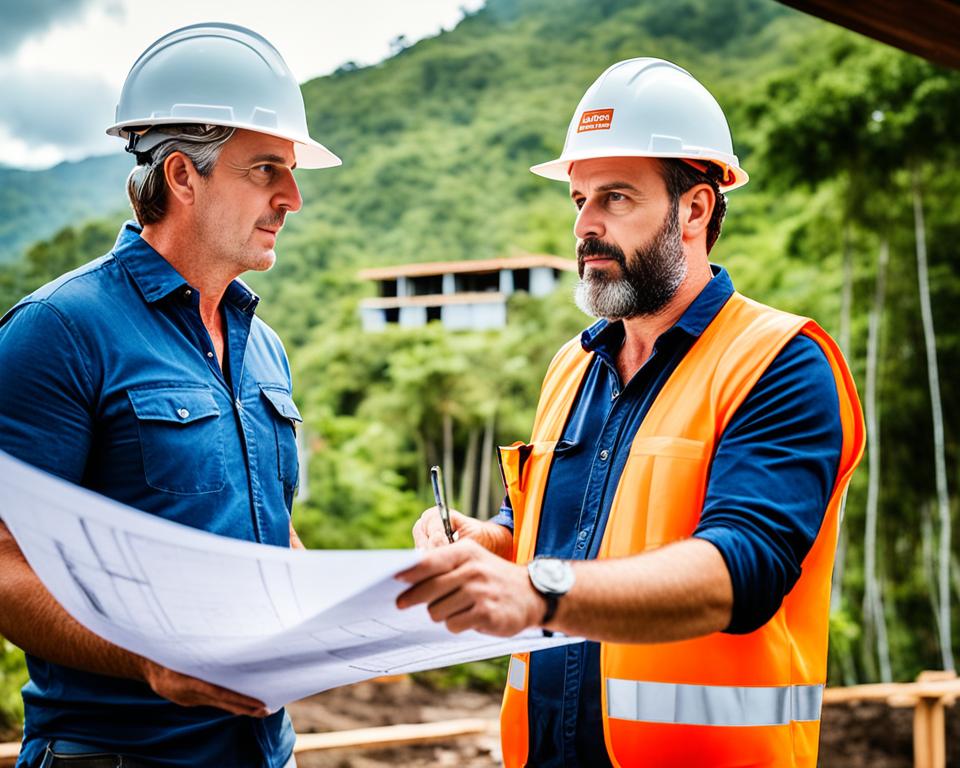
Key Benefits of Hiring an Attorney and Contractor/Architect
- Ensures legal compliance and protects the buyer’s interests
- Identifies and mitigates potential site-related issues early on
- Provides expert guidance on building codes, materials, and construction methods
- Facilitates a smooth and efficient construction process
- Helps to minimize risks and potential problems throughout the project
Building a home in Costa Rica needs a careful and team effort. With a real estate attorney and a skilled contractor or architect, you can move forward with confidence. They help you build your dream home in this stunning country.
Purchasing the Property
Buying a home in Costa Rica is a big step. It’s smart to work with a trusted Costa Rican real estate lawyer. They’ll check the property’s title, make sure there are no issues, and help with the closing process. They’ll also handle taxes and fees.
Thinking about is it worth buying property in costa rica? means looking at the market. Prices change based on where the property is, like oceanfront or in the city. Real estate agents charge 5% to 10% of the sale price, which is normal.
For how much does a prefab house cost in costa rica?, you can use mortgages, trusts, cash, or financing from developers. But, getting a bank loan as a foreigner can be hard. You might need to look for private lenders instead.
Getting the buyer’s lawyer to check the property is key. They make sure the title is clear and everything meets the law. This helps avoid problems and keeps the buyer safe.
The lawyer’s work includes checking the title, looking into the owner’s background, and reviewing documents. This ensures the property is good to go.
Buying property in Costa Rica costs about 1% to 2% in legal fees, based on the deal’s details and the lawyer’s work. Total costs can be around 4% of the property’s value, with fees for things like Registry and Municipality.
Foreigners can own up to 49% of properties in the Maritime Terrestrial Zone (MTZ). Property taxes are 0.25% of the property’s value, paid every 3 months or all at once for the year to the local government.

Buying property in Costa Rica needs careful thought and a real estate lawyer’s help. They guide you through the legal stuff and make sure the deal goes smoothly. Knowing the details helps you decide and get your dream home in this lovely country.
Assembling Your Building Team
After finding the perfect property, the next big step is to gather a skilled building team in Costa Rica. This team should include a Costa Rican architect and engineer. They are key to making your home-building project a success.
The Role of Architects and Engineers
The architect is in charge of designing and planning your custom home in Costa Rica. They will work with you to make sure your dream home is turned into a detailed plan. This plan must meet your wishes and follow local building rules.
They also watch over the building process. This ensures your home is built just as the design says.
Next to the architect, an engineer is also vital. They focus on the technical parts of the project. This includes checking the structure’s strength and designing important systems like plumbing and electrical. Their work makes sure your house in Costa Rica is safe and works well.
When picking your building team, it’s important to find well-known professionals with a good history in building homes in Costa Rica. They know all about local rules, building ways, and green building methods. This knowledge can really help your project do well.
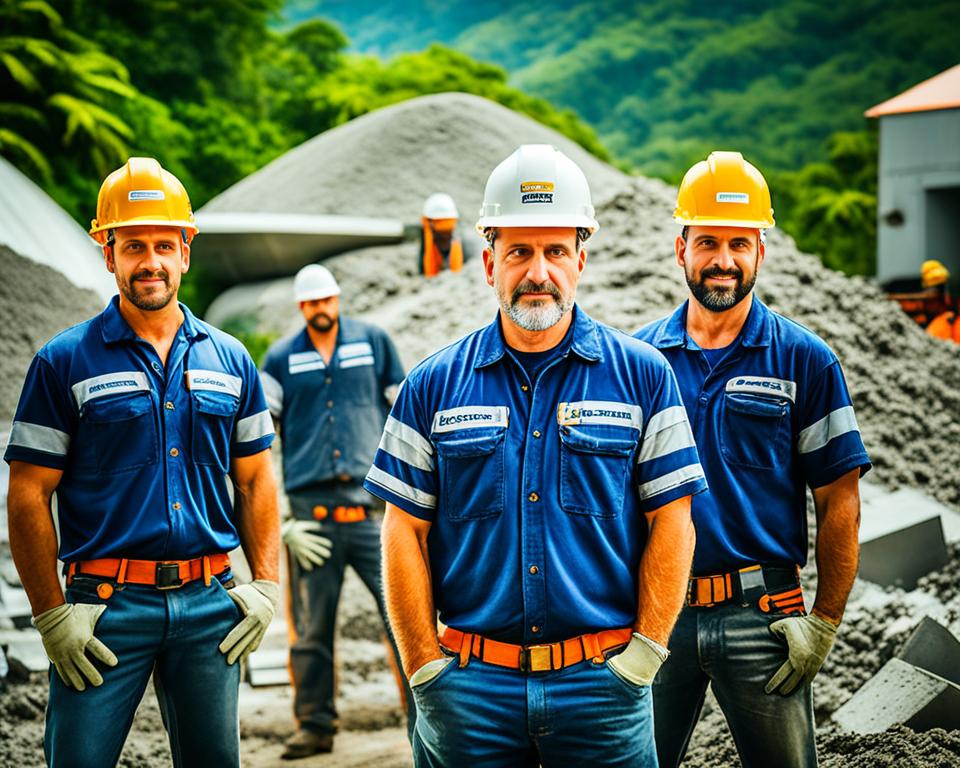
Working with a talented architect and engineer means you can trust that your custom home in Costa Rica will be top-notch. It will be built to the highest standards, making the building process smooth and fun.
Home Builders in Costa Rica
Costa Rica is home to many skilled and respected home builders. They focus on building custom homes, luxury properties, and eco-friendly houses. These builders know the local building codes, environmental laws, and the tropical architecture well.
Well-known Costa Rican home builders include Tom Terry, Humberto Rubi, Mike Brussock, Mike Tell, J P Lamarche, and Federico A. Marin-Schumacher. They are known for their quality work in eco-friendly and sustainable housing. Their projects fit well with Costa Rica’s green and tropical look.
Choosing a trusted Costa Rican home builder makes building your dream home easy and smooth. They help you with the challenges of building green and sustainable in Costa Rica. They make sure your project follows all environmental laws.
For custom home building in Costa Rica, having a builder with local knowledge is key. Working with the right team lets you build your tropical dream home. They help you overcome the unique challenges of building in this beautiful country.
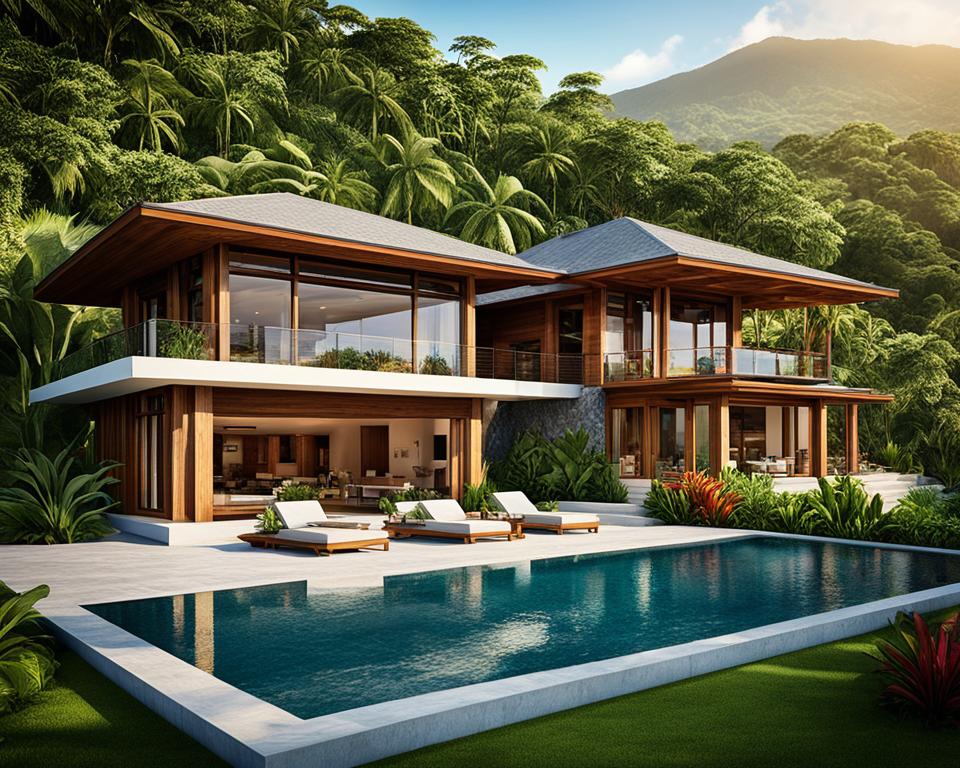
The Design Phase
Building a home in Costa Rica is a detailed process. The design phase is key, setting the project’s foundation. It brings together homeowners, Costa Rican architects, and design experts. They work together to make the homeowner’s dream a reality, fitting well with the local environment.
Steps in the Design Process
The design process for a home in Costa Rica includes several steps:
- Creating a detailed design brief that covers the homeowner’s likes, needs, and lifestyle.
- Doing a thorough land survey to understand the site’s features and challenges.
- Testing the soil to make sure it can handle the planned construction.
- Building a detailed 3D model of the home for homeowners to see and decide on.
- Creating blueprints that list materials, finishes, and how to build it.
This teamwork ensures the final project in Costa Rica fits the homeowner’s needs and blends with the area’s sustainable development. The design phase is key for making the home energy-efficient, earthquake-safe, and eco-friendly. It’s vital for architects and builders in Costa Rica.
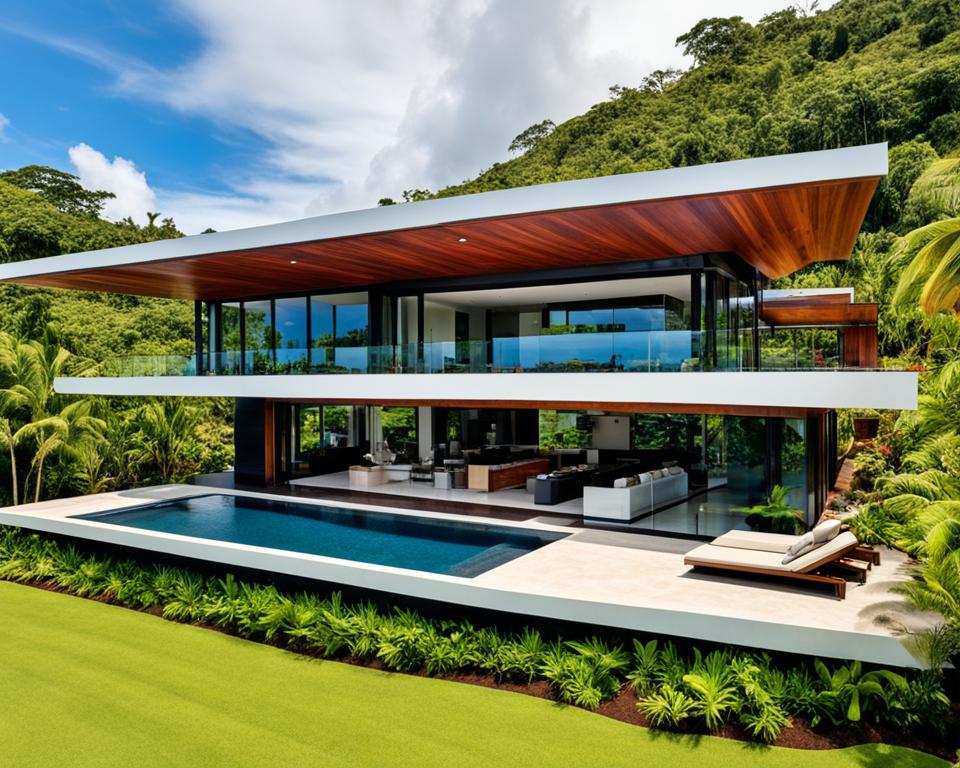
By focusing on a detailed design process, homeowners can make sure their beachfront homes meet their tastes. They also ensure it fits the eco-friendly and tropical building standards of Costa Rica.
Building a Home in Costa Rica
Building a new home in Costa Rica is exciting and rewarding. But, it needs careful planning and working with experts. After designing and getting permits, you can start building.
When starting a new home project in Costa Rica, keep in touch with your contractor and architect. This helps solve problems and keeps the project on track. It’s key to work with pros who know the local building scene well.
The building process in Costa Rica includes several steps:
- Site preparation and foundation work
- Framing and structural elements
- Installing electrical, plumbing, and HVAC systems
- Exterior finishes, like roofing and siding
- Interior finishes, including flooring, walls, and fixtures
- Landscaping and outdoor features
Homeowners should stay involved and check in with their contractor. This ensures the final product matches their vision and the original design. Regular site visits and updates are important for a smooth build.
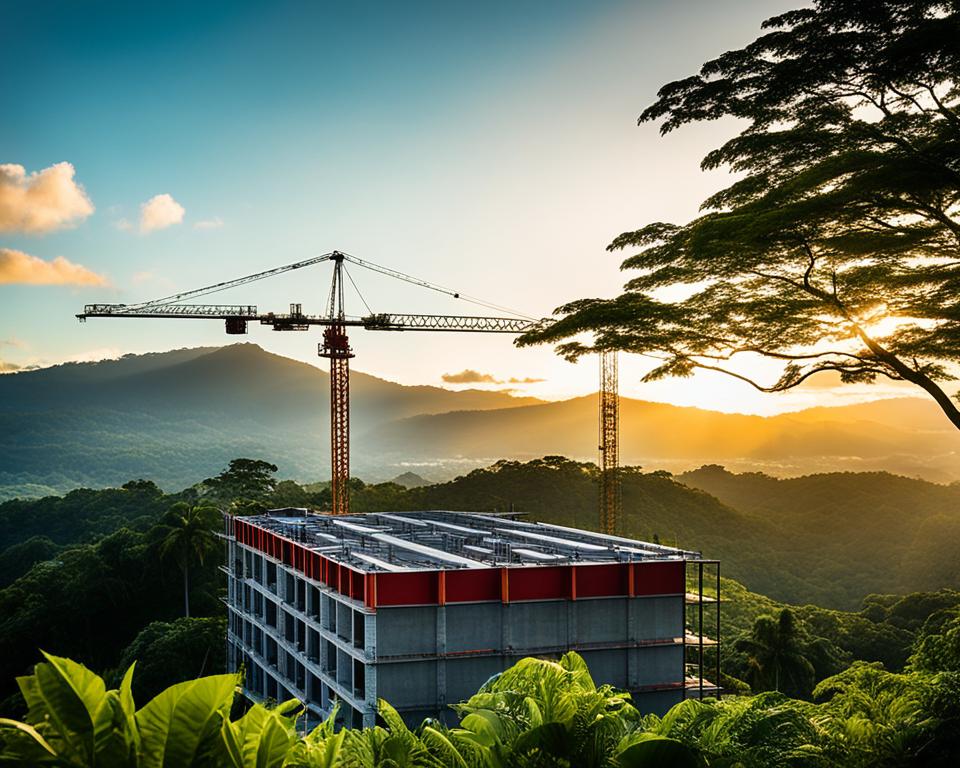
Working with skilled builders in Costa Rica and following local rules and best practices helps. This way, homeowners can make their dream home a reality. They get a beautiful, useful home that fits their needs and tastes.
Cost Considerations
Building a home in Costa Rica is exciting and rewarding. But, it’s key to know the costs. On average, building a home costs $125 to $150 per square foot. The first payment is usually 10% of the total cost.
The cost changes based on where you build. Homes in the Central Valley are cheaper, costing $70 to $110 per square foot. Beachfront homes are pricier, from $120 to $180 per square foot. Don’t forget to add legal fees, permits, and property taxes to the cost.
Choosing costa rican construction companies and eco-friendly home construction costa rica affects the price. Sustainable construction costa rica and eco-friendly homes costa rica might cost more upfront. But, they can save money on bills and are better for the planet.
Knowing these costs is key to a realistic budget and a successful project. By planning and researching, homeowners can make smart choices and avoid surprises.
To summarize the key cost considerations when building a home in Costa Rica:
- Construction costs range from $125 to $150 per square foot, with a 10% initial payment to the builder.
- Homes in the Central Valley are generally less expensive ($70 to $110 per square foot) compared to beachfront properties ($120 to $180 per square foot).
- Additional expenses include legal fees, permits, and property taxes, which can add significantly to the overall cost.
- Sustainable and eco-friendly construction methods may have higher upfront costs but can lead to long-term savings.
Understanding these costs and planning well ensures a successful and financially smart home-building experience in Costa Rica.
Environmental Regulations and Restrictions
Costa Rica is known for its strong environmental protection. This includes the construction industry. Homeowners and builders must follow strict rules when building homes in Costa Rica.
One key rule is a 200-meter setback from the coastline, where building is mostly banned. This helps protect the beaches and marine life. Also, foreigners can only own up to 49% of coastal land.
Getting permits and approvals can take months. This is because projects must pass tough environmental checks. The National Environmental Office (SETENA) checks if a project is good for the environment before giving the green light.
To follow these rules, it’s smart for homeowners and builders to work with experts. Architects and lawyers know a lot about building homes that are good for the environment in Costa Rica. This way, projects can be done right and meet Costa Rica’s green goals.
Key Considerations
- 200-meter setback from the coastline where new construction is generally prohibited
- Foreigners are limited to owning no more than 49% of land in the Maritime Zone
- Obtaining permits and approvals can take several months due to rigorous environmental impact assessments
- The National Environmental Office (SETENA) plays a crucial role in evaluating and approving construction projects
- Working with local experts, such as architects and lawyers, can help navigate these environmental considerations
Obtaining Permits and Time Constraints
Building a home in Costa Rica means getting many permits and approvals. This process takes time. You’ll need permits from the local government and possibly environmental or coastal zone approvals. Getting these permits can take months, so plan your construction timeline accordingly.
After getting permits, you have two years to finish your eco-friendly home in Costa Rica. If you go over this time, you might need a new permit. Working with local experts in construction, architects, and lawyers can help you meet deadlines.
Building a sustainable home in Costa Rica means knowing about the permits you need. This includes:
- Municipal permits for construction
- Environmental permits for projects in protected or sensitive areas
- Coastal zone permits for properties near the ocean
- Approval from homeowners associations or community organizations, if applicable
The process for getting permits varies by location and project type. It’s key to have a skilled team to help you. They can make sure your eco-friendly home is built on time.
Conclusion
Building a home in Costa Rica is both rewarding and exciting. It lets you design a space that fits your needs in a beautiful country. But, it’s important to plan well and work with experienced home builders in costa rica.
Choosing the right lot and building team is crucial. So is understanding the design and costs. Each step in costa rica real estate development has its own challenges and chances.
Working with reputable residential construction companies helps homeowners make their dream home a reality. They can enjoy living in this tropical paradise. With a focus on custom home design and build, luxury property builders, and green building contractors, homes in Costa Rica are sustainable and save money in the long run.
The journey to build a home in Costa Rica is full of possibilities. With the help of local experts, homeowners can make a space that suits their lifestyle and dreams.
FAQ
What is the average price to build a house in Costa Rica?
How much does it cost to build a casita in Costa Rica?
How long does it take to build a house in Costa Rica?
Do you need a permit to build a house in Costa Rica?
What is the difference between a villa and a casita?
Is it worth buying property in Costa Rica?
How much does a prefab house cost in Costa Rica?
How much does an architect cost in Costa Rica?
Source Links
- https://www.twoweeksincostarica.com/building-house-costa-rica/
- https://crie.cr/building-a-home-in-costa-rica-2/
- https://www.architecture.cr/post/4-important-details-to-consider-before-building-a-house-in-costa-rica
- https://www.tresamigos-cr.com/should-you-buy-or-build-home-costa-rica
- https://rebeccaclower.com/construction/build-or-buy-a-house-in-costa-rica-start-here
- https://bluewaterpropertiesofcostarica.com/blog/building-buying-a-house-in-costa-rica-pros-cons/
- https://www.costarican-american-connection.com/building-home-costa-rica
- https://bluewaterpropertiesofcostarica.com/blog/building-a-home-in-costa-rica-costs-beginning-steps/
- https://www.arquitectosjh.com/en/blog-jh/what-you-need-to-know-before-buying-land-to-build-in-costa-rica/
- https://ticonstru.com/en/buildwire/updated-guide-to-building-in-costa-rica/
- https://www.costaricaguide.co.cr/real-estate/buying-process/buying-building.html
- https://crie.cr/building-a-home-in-costa-rica/
- https://aglegal.com/real-estate-law/buying-property-in-costa-rica/
- https://www.dominicalproperty.com/purchasing-property-in-costa-rica-faqs/
- https://www.remax-oceansurf-cr.com/costa-rica-home-building
- https://decentrahomes.com/custom-home-builder-in-tamarindo/
- https://synergyconsultingcr.com/guanacaste-construction-consulting/
- https://decentrahomes.com/
- https://www.gaprealestate.com/about-us/
- https://www.fugahomedesigns.com/
- https://www.costaconstructioncr.com/
- https://www.sarcoarchitects.com/why-hire-an-architect-led-design-build-firm-as-your-costa-rica-home-builders
- https://rebeccaclower.com/construction/new-construction-in-costa-rica-modern-methods-to-consider
- https://www.corban.cr/post/designer-house-in-costa-rica
- https://www.gaprealestate.com/list-my-property/
- https://www.sarcoarchitects.com/how-to-design-a-home-in-costa-rica
- https://www.architecture.cr/post/the-real-price-of-building-a-house-in-costa-rica
- https://www.tresamigos-cr.com/building-a-home-in-costa-rica
- https://www.gaprealestate.com/differences-between-open-and-exclusive-listings-in-real-estate/
- https://www.remax-oceansurf-cr.com/construction-cost-in-costa-rica
- https://bluewaterpropertiesofcostarica.com/blog/costa-rica-home-building-costs-increasing-2023-update/
- https://howlermag.com/how-much-does-building-cost/
- https://crie.cr/about-costa-rica-environmental-laws/
- http://costarica-information.com/about-costa-rica/politics-and-government/environmental-protection-laws-1
- http://guidetocostaricarealestate.com/christopher-howards-guide-to-real-estate-in-costa-rica/christopher-howards-guide-to-real-estate-in-costa-rica/chapter-9-permitting
- https://www.gaprealestate.com/understanding-open-listings-in-real-estate-in-costa-rica/
- https://www.costarica.com/real-estate/building-process
- https://archive.doingbusiness.org/content/dam/doingBusiness/country/c/costa-rica/CRI.pdf
- https://ticotimes.net/2015/10/03/if-building-in-costa-rica-know-your-water-rights-before-you-buy
- https://magnolia.cr/costa-rica-custom-home-builders/
- https://www.corban.cr/post/average-costof-buildinga-house-in-costa-rica
- https://www.arquitectosjh.com/en/blog-jh/how-long-does-it-take-to-build-a-house-in-costa-rica/

